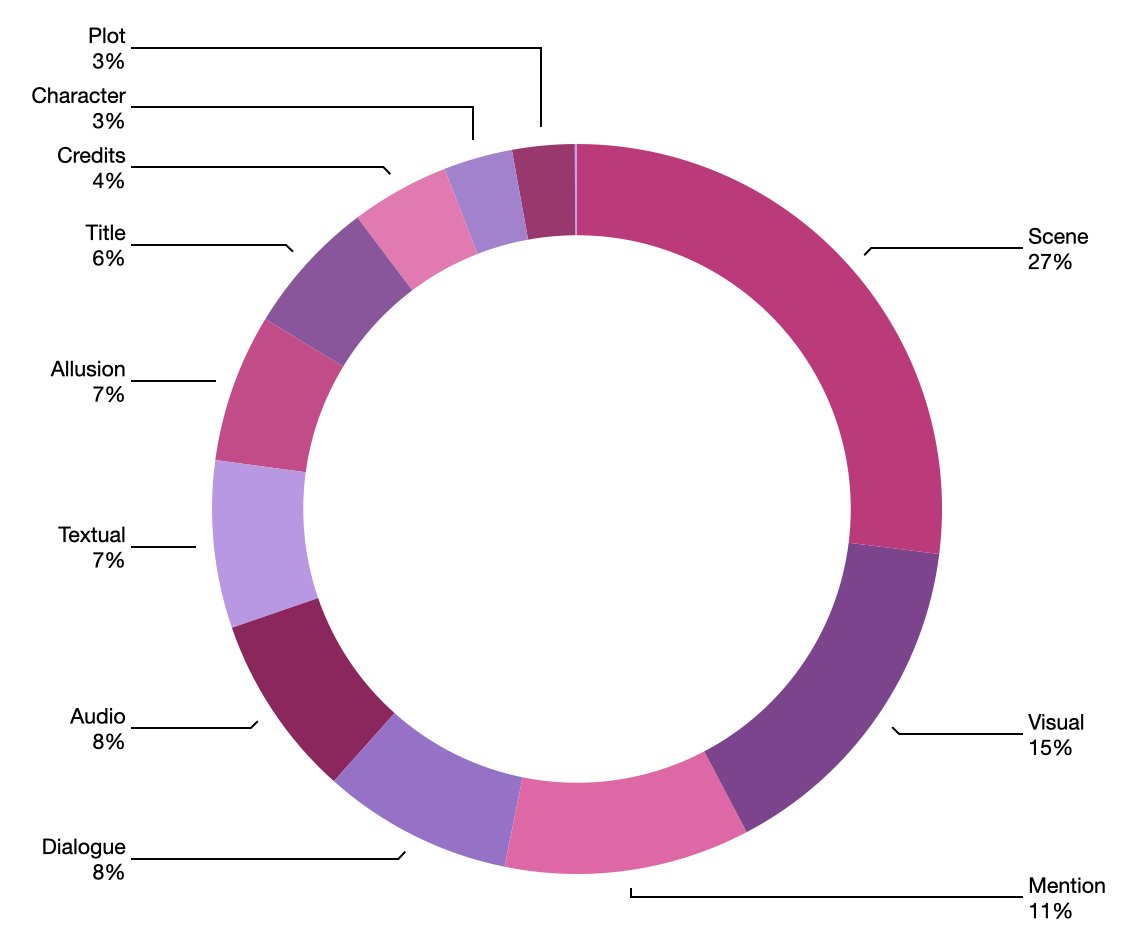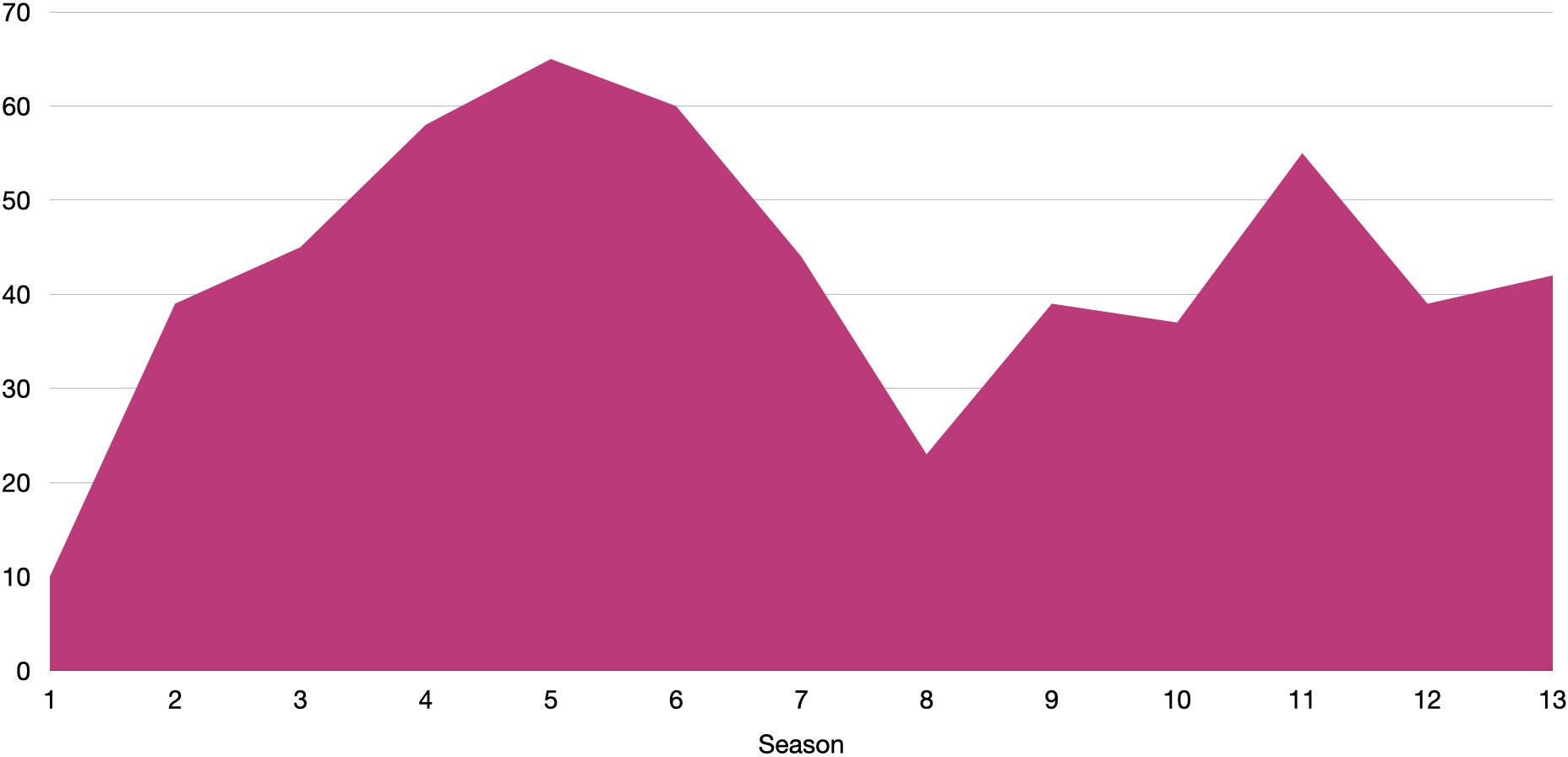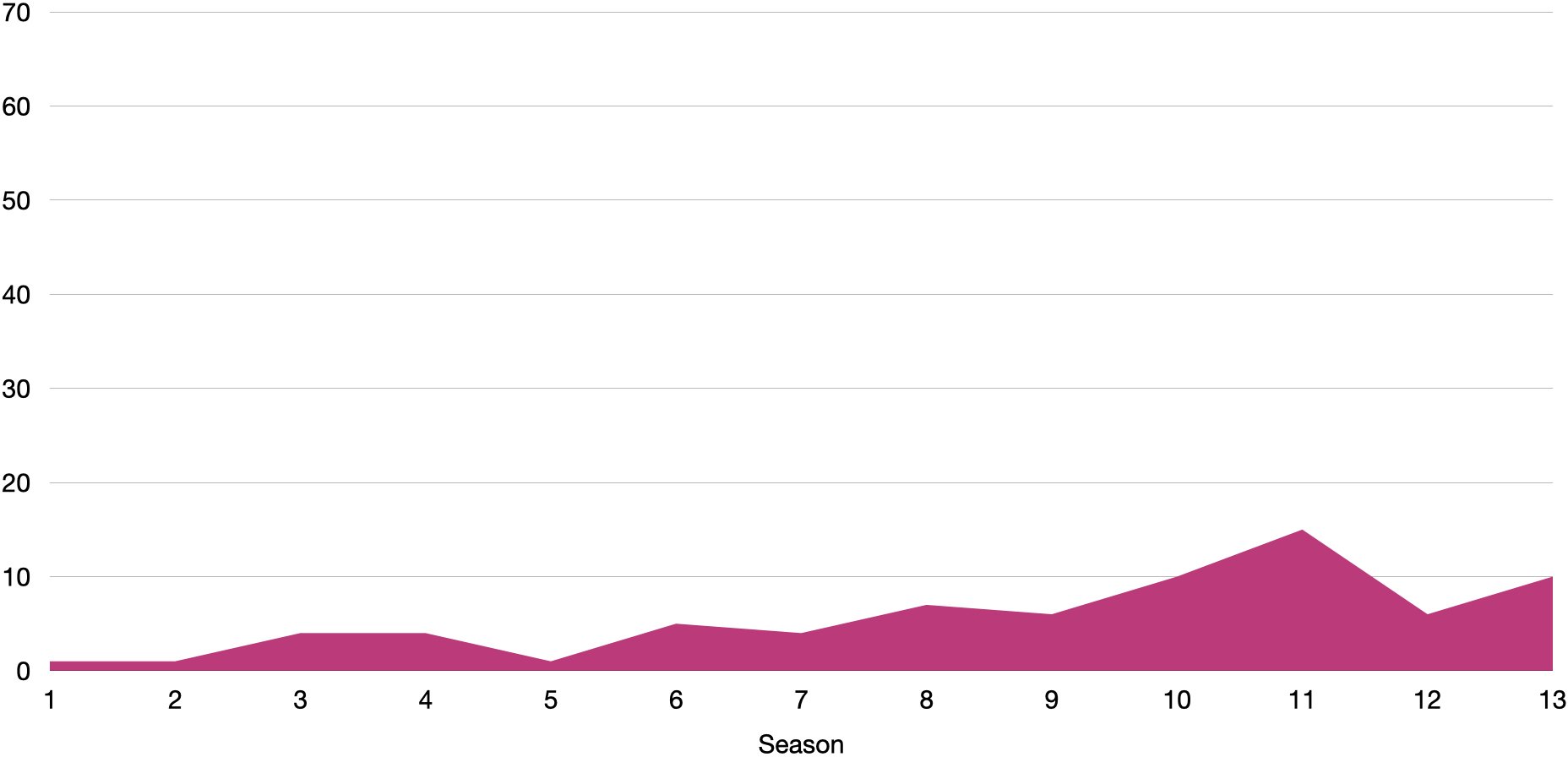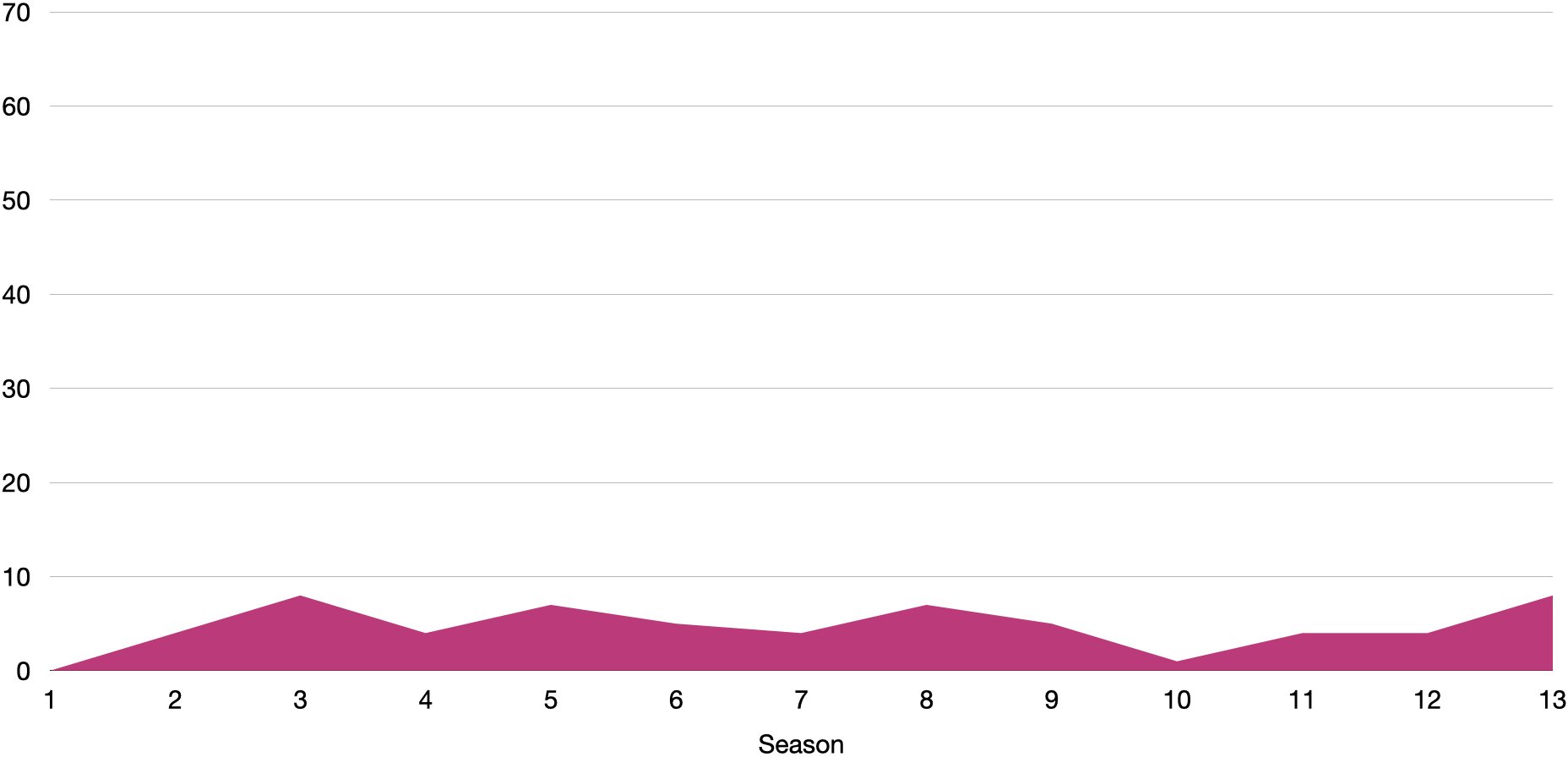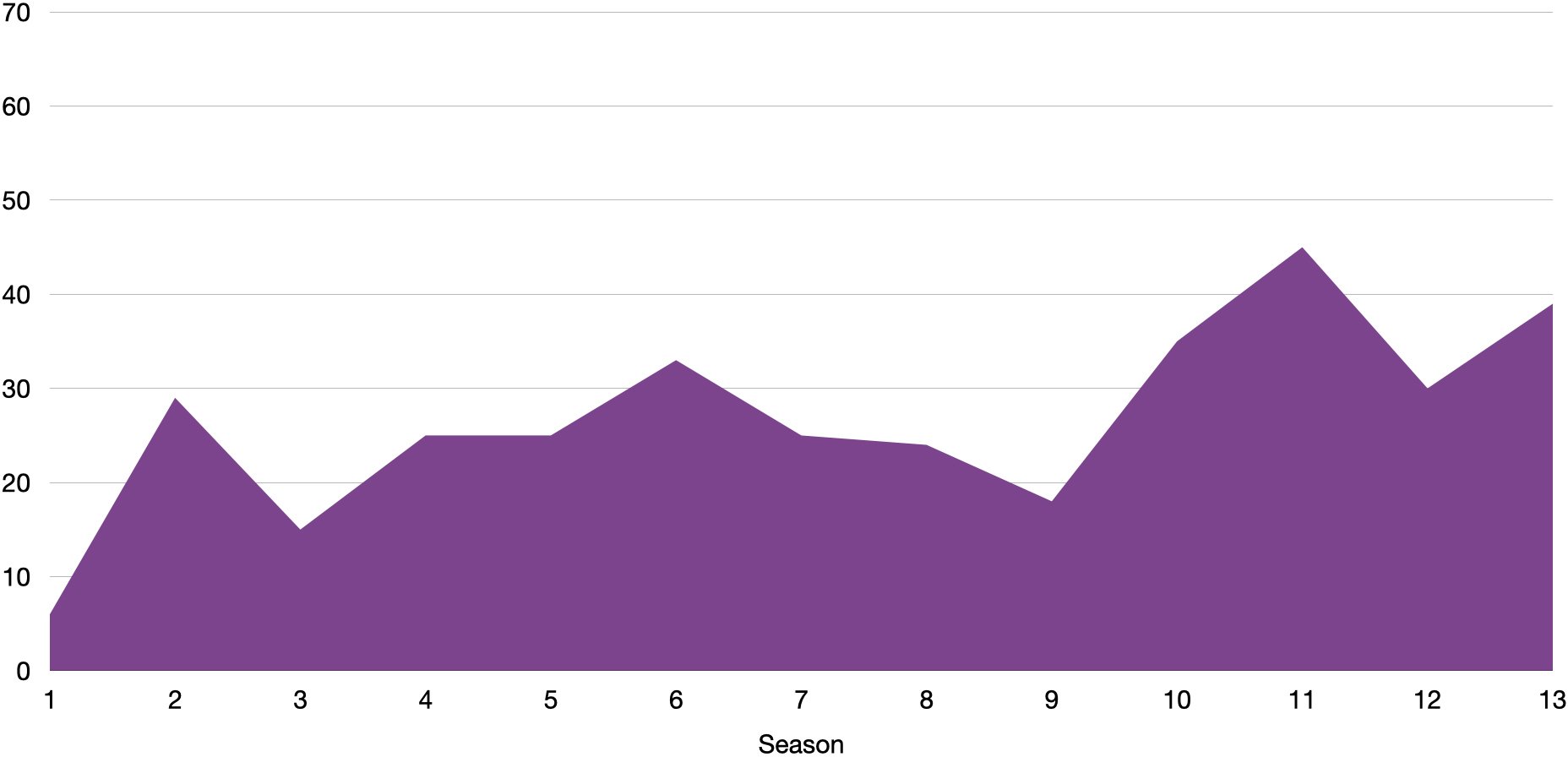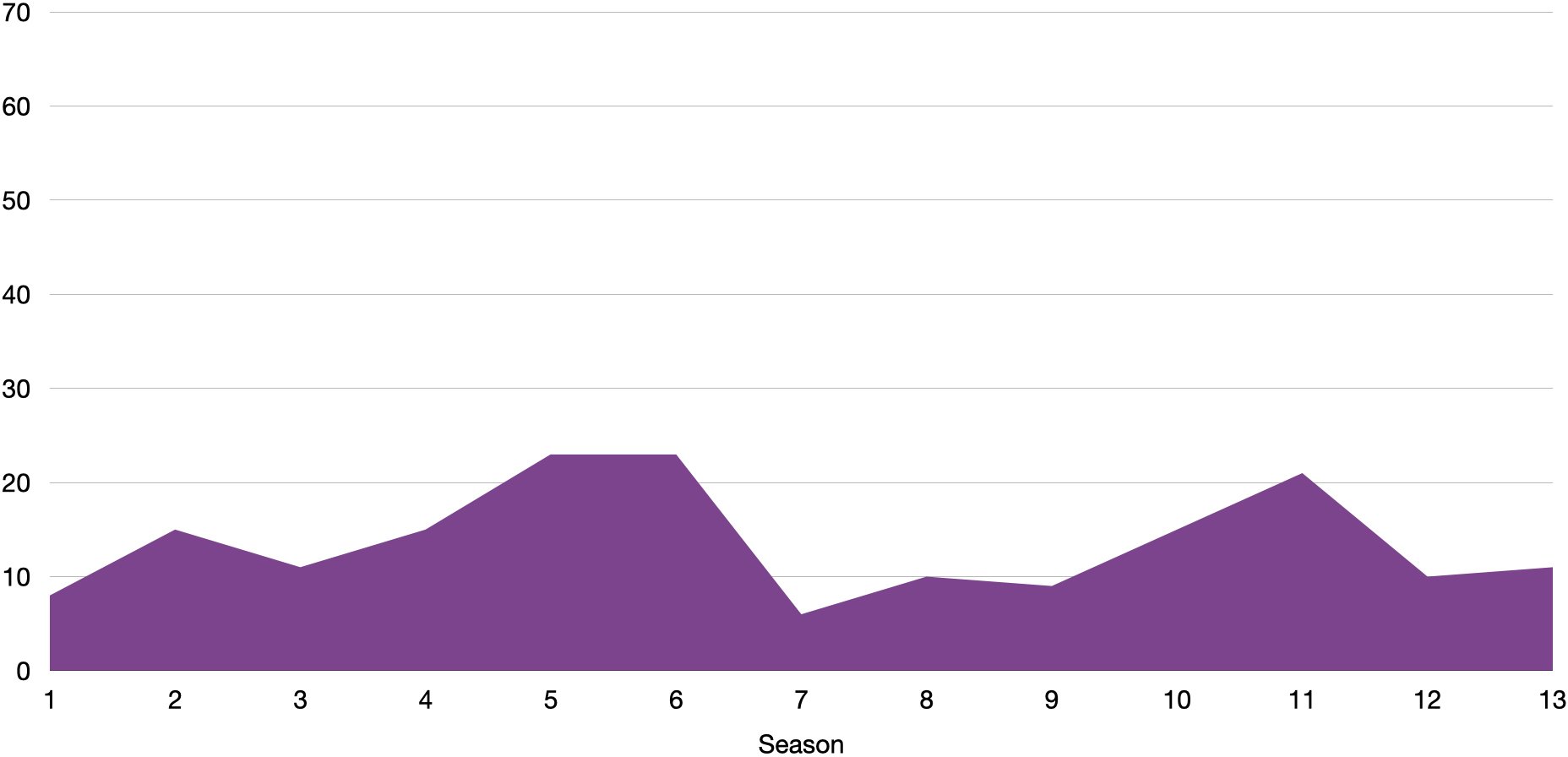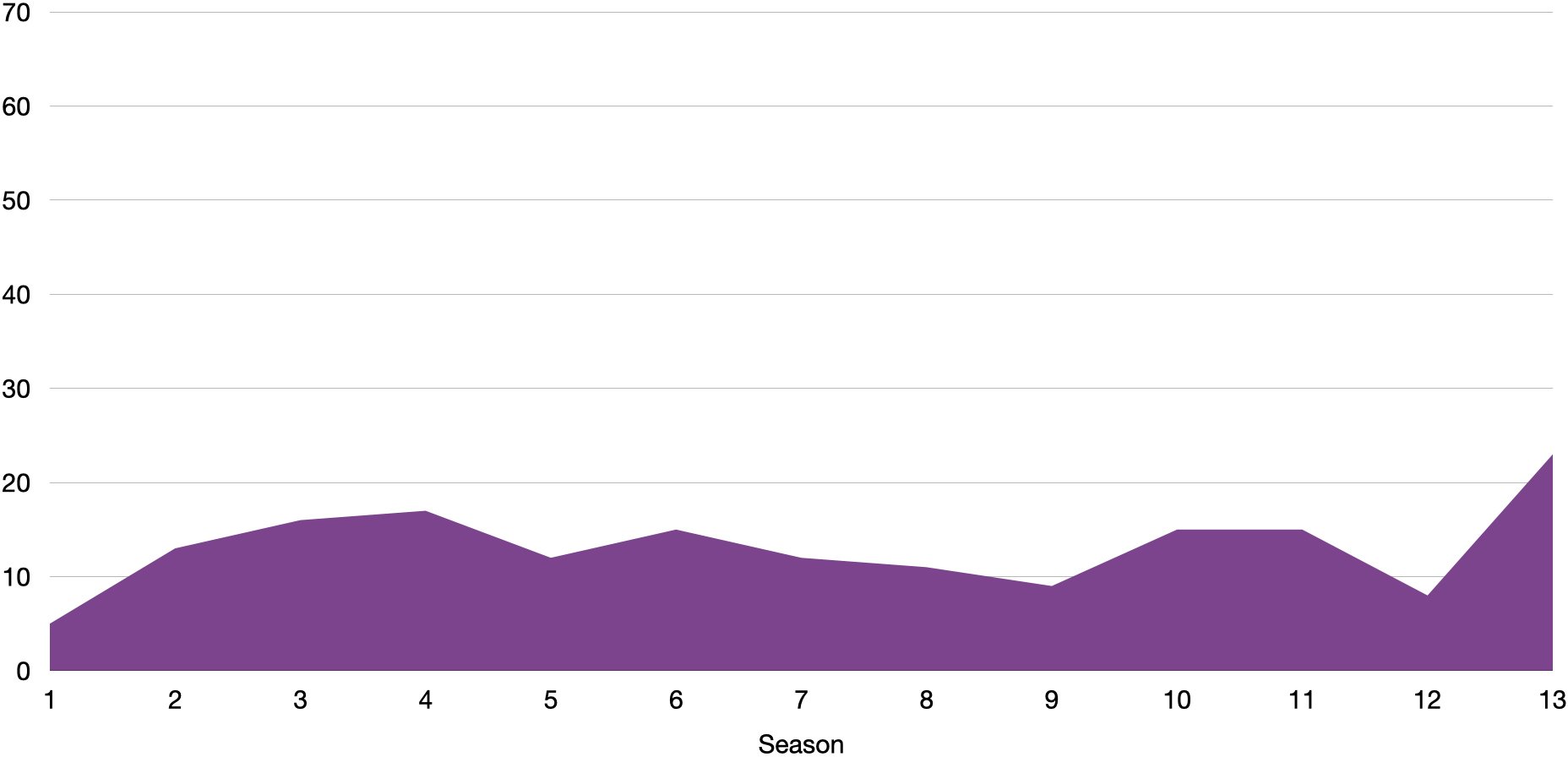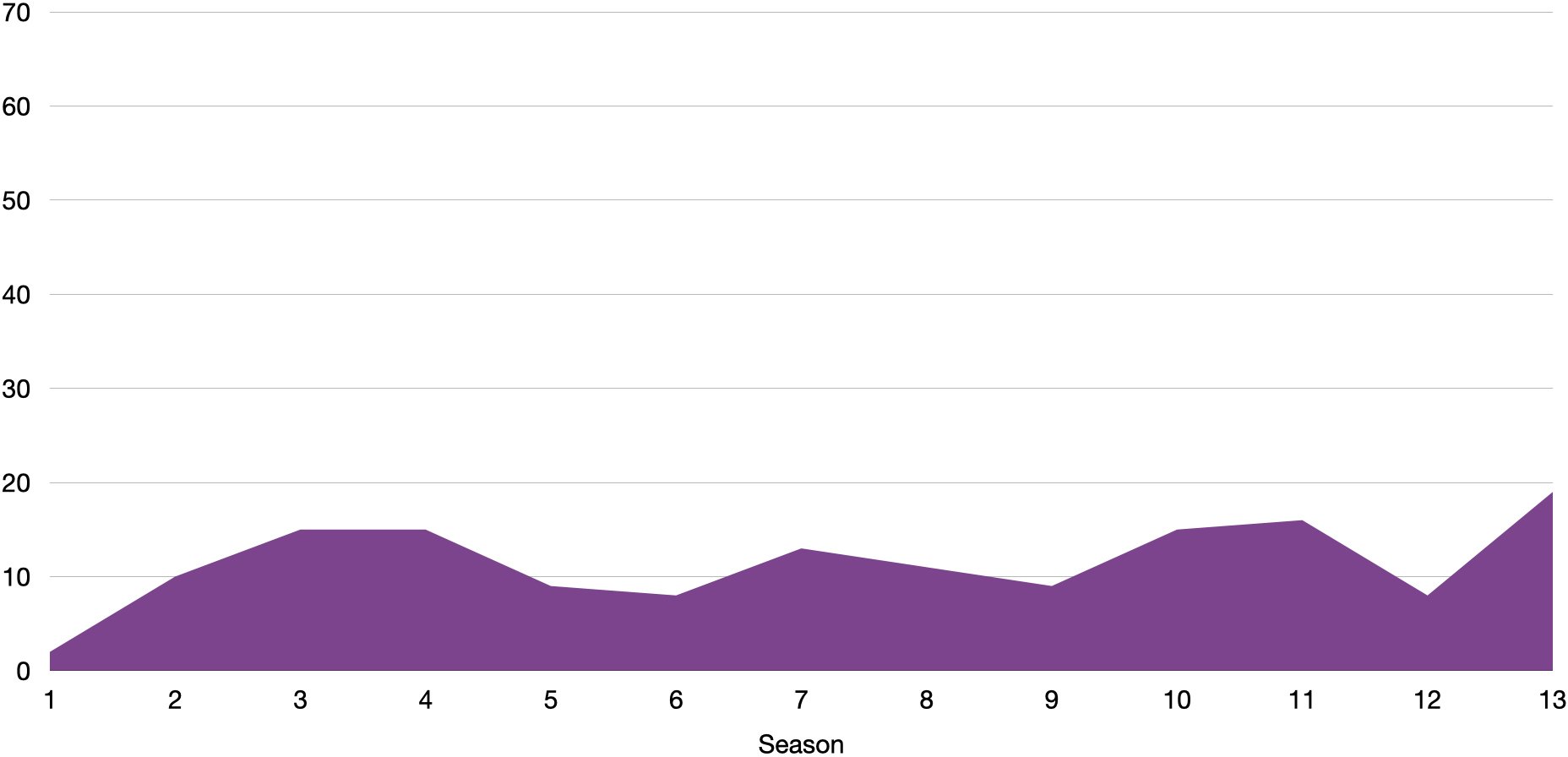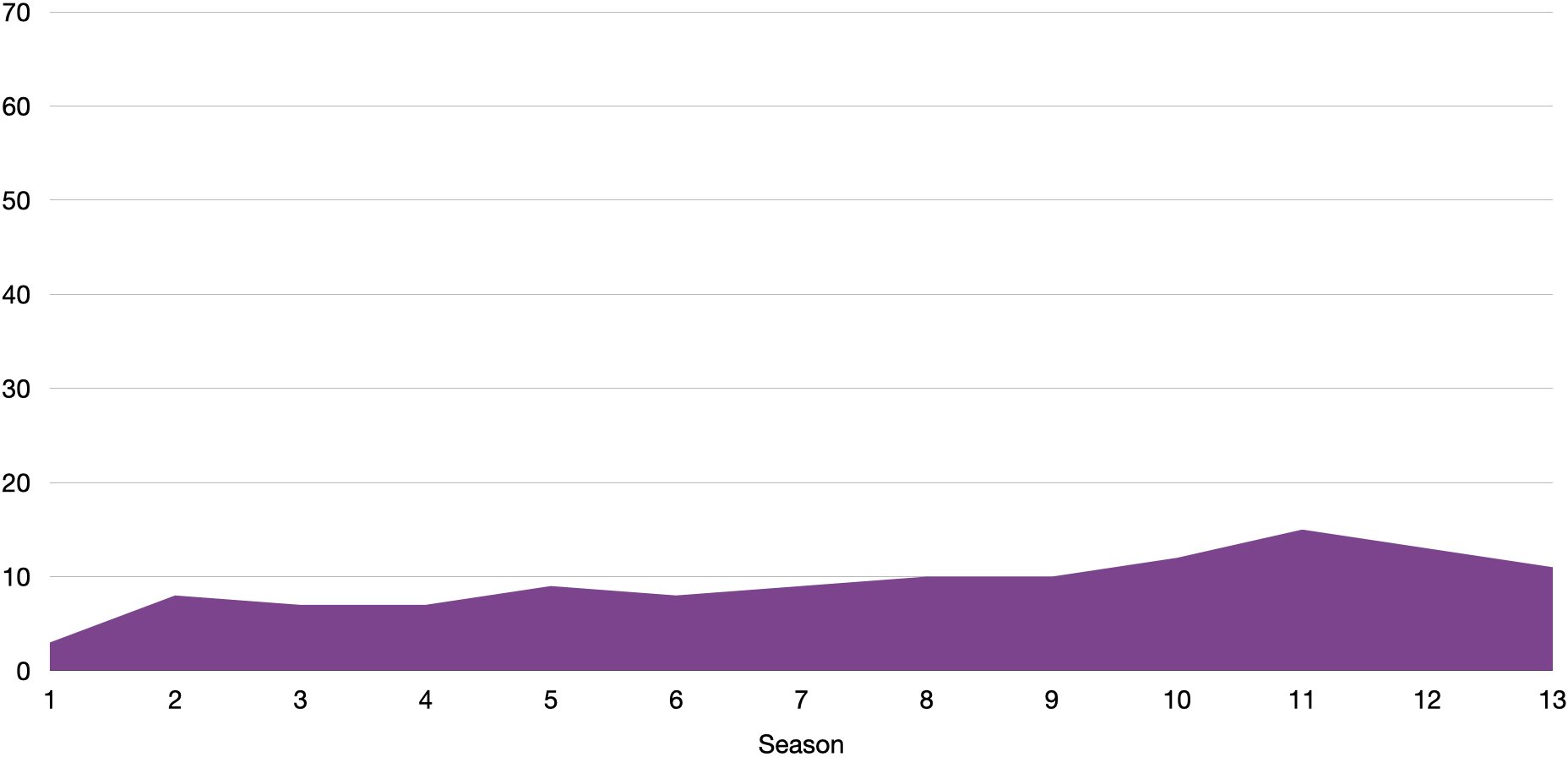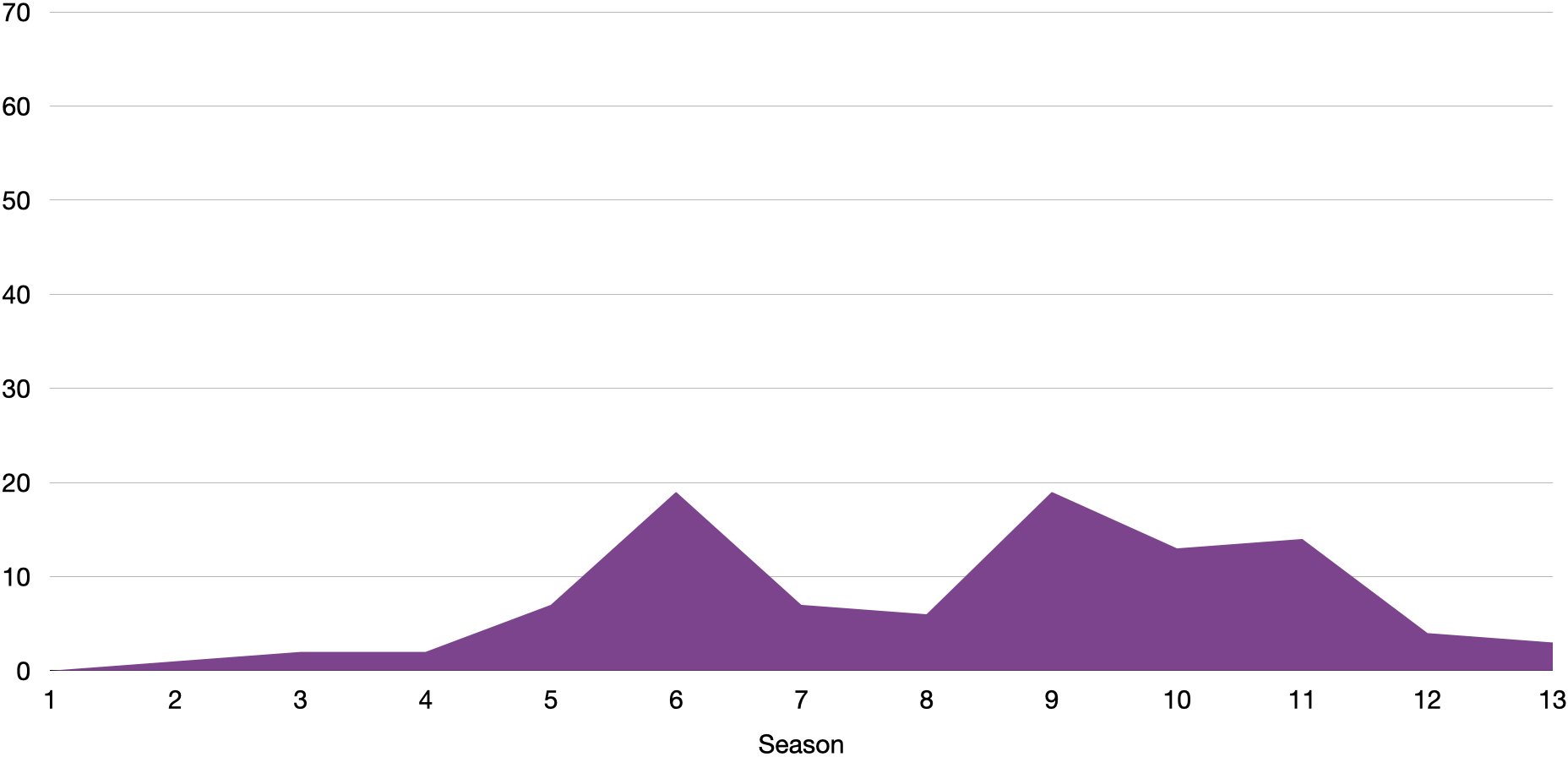Anatomy of a Parody: Every Type of Movie Reference on The Simpsons
How common are episode-long movie parodies on The Simpsons? Are there more cinematic sign gags or cribbed lines of dialogue? When we started the Springfield Googolplex podcast to dive deep into movie references on The Simpsons, we quickly realized we had a lots of hard-to-answer questions.
Movie References by Type on The Simpsons.
That’s why when we began compiling the Simpsons Movie Reference Database (SMRDb), we decided to do something a little differently than every other compilation of Simpsons references on the internet. We categorized every single reference in the first 13 seasons into one of 11 types:
Scene
Visual
Mention
Dialogue
Audio
Textual
Allusion
Title
Credits
Character
Plot
This categorization helps us better understand the wide variety of cinematic nods made by the writers, animators, cast, and crew of The Simpsons—and how they’ve changed over time.
In this article, we break down every type of movie reference on The Simpsons, from major references like recreations of entire scenes to minor references like sign gags, music cues, or cinematography.
Major References (33%)
When fans of The Simpsons think of movie references, they’re probably mostly thinking of major references. In the SMRDb, we consider major references as any Simpsons scene, character, or plot based on a movie.
Usually, these take the form of parodies, which recreate a recognizable movie moment with a comedic Simpsons twist on the source material. Other times, they take the form of homages (“French for theft,” as they say on the commentary), which generally leave out the twist.
Scene References (27%)
The most common type of reference on The Simpsons overall is the scene parody. In this reference type, a scene from a movie is reenacted by characters from the TV show, combining elements of story, dialogue, visuals, and score.
Half the fun of these types of parodies is seeing which Simpsons character is cast in which role, and often these casting choices tell us something about the character. For example, over the course of the first 13 seasons, Homer, Bart, and Groundskeeper Willie have all played the role of Quint the shark hunter from Jaws (1975). What do they all have in common?
The number of scene references to movies throughout the first 13 seasons of The Simpsons.
In terms of change over time on the show, the number of scene references rose steadily in seasons 3 and 4 under cinephile showrunners Al Jean and Mike Reiss and peaked in season 5 under David Mirkin. This kind of overt movie reference declined under showrunners Bill Oakley and Josh Weinstein as they took the show more toward personal stories and original material. But they came roaring back under Mike Scully, who brought more contemporary pop culture into the show, and unsurprisingly continued with the return of Al Jean.
Character References (3%)
Character references work one of two ways on The Simpsons. In the first case, the character from a movie simply shows up. For example, did you know the Swedish scientist with the black sunglasses in “Marge vs. the Monorail” (S4E12) is essentially Max von Sydow’s character in Until the End of the World (1991)?
In the second case, some of the most memorable side characters on the show were directly inspired by movie characters, like Professor Frink as a parody of Jerry Lewis in The Nutty Professor (1963) or Gil as a parody of Jack Lemmon in Glengarry Glen Ross (1992). However, these characters often evolve far beyond their parody origins to become more fully rounded as the show goes on.
The number of movie character references throughout the first 13 seasons of The Simpsons.
Starting from modest beginnings, character cameos grew steadily throughout the first 13 seasons, peaking in season 11 under Mike Scully with a slew of cameos from recent films like Léon: The Professional (1994) as well as classics like One Flew Over the Cuckoo's Nest (1975).
Plot References (3%)
When we started the Springfield Googolplex podcast, we mistakenly remembered The Simpsons doing episode-long movie parodies on a regular basis. As it turns out, this is surprisingly rare.
Of course, the Treehouse of Horror series often features full segments that parody the plot or world of a horror movie or TV series, like King Kong (1933) in “Treehouse of Horror III” (S4E5). Outside of that, a few episodes take the premise of a movie and run with it, like in “Bart of Darkness” (S6E1), where a summer story about the Simpson family getting a pool turns into a parody of Rear Window (1954) in the second half, or “Bart Gets Hit by a Car” (S2E10), which takes its medical scam set-up from the little-known film The Fortune Cookie (1966). But these are very much the exception, not the rule.
The number of movie plot references throughout the first 13 seasons of The Simpsons.
While uncommon, plot parodies have been a relatively consistent part of the show’s DNA throughout the first 13 seasons, with two high-water marks in seasons 3 under Al Jean and Mike Reiss and again under Al Jean in season 13.
Minor References (66%)
While scenes, characters, and plots may be the most recognizable movie reference types to most Simpsons fans, minor references outnumber these major references two to one. These include the countless little audiovisual, textual, spoken, and meta nods to movies that fans continue to find in The Simpsons years later.
Over the course of the first 13 seasons, the balance also shifted from major references to minor ones. At the high-water mark for major references in season 5, they made up about 39% of all references, while at the high water-mark for all types of references in season 11, they only made up about 30%.
Visual References (15%)
The first few seasons of The Simpsons redefined TV animation. By shifting its backgrounds from labor-intensive, hand-painted settings of the Hanna-Barbera era to line drawings that work more like the foreground, they were able to suddenly incorporate cinematic visuals that we rarely saw on TV—in animation or live action, frankly.
So where did the animators find inspiration to make use of their newfound freedom? The all-time greatest filmmakers, of course. As a result, The Simpsons is filled with visual references to the suspenseful editing and lighting of Alfred Hitchcock, the framing and blocking of Steven Spielberg, and even the production design of Ken Adam, as seen in Dr. Strangelove (1964) or Goldfinger (1964).
But the tools of filmmaking aren’t the only types of visual references on the show. The backgrounds of scenes are frequently populated with movie memorabilia like posters and action figures. Sometimes famous movie characters even show up only in the background. (We count these as visual, rather than character references if they keep their mouths shut.) In addition to being the King of the Monsters, Godzilla (1954) is the king of these kinds of background references on The Simpsons.
The number of visual movie references throughout the first 13 seasons of The Simpsons.
Visual references kicked into high gear in season 2 under the original showrunners as the show found its legs in terms of animation, and continued to grow fairly steadily to a peak in season 11 under Mike Scully. Over time, the balance of these references also shifted from cinematography to more and more Easter eggs in the background.
Mentions (11%)
One of the most direct (and easiest to fact check) types of movie references on The Simpsons is when a character mentions a movie by name or makes a pun using its title.
The most interesting version of this is when a movie is only ever mentioned and never parodied in any other way, like Police Academy (1984). If full-on parodies are often a sign of affection on the part of the writers and animators, these types of mention-only references can sometimes be read a sign of distain.
The number of movie title mentions throughout the first 13 seasons of The Simpsons.
As references overall shifted from longer parodies to more small pop culture nods throughout the first 13 seasons, movie mentions also grew, reaching their first peak in season 6 under David Mirkin and an even higher peak in season 11 under Mike Scully.
Dialogue References (8%)
Dialogue references borrow one or more spoken lines from a movie. Usually, these are lines ripped from some of history’s most celebrated movies, the kinds of lines you might hear in a clip from an AFI 100 Movies… special or an Oscar-night sizzle reel.
But other times, they’re simply lines from a writer’s favorite deep cut. For example, while most millennials might chant, “One of us, one of us!” in reference to The Simpsons episode “No Disgrace Like Home” (S1E4), it originally comes from the movie Freaks (1932).
Much like casting in scene parodies, often the comedy of dialogue references comes from how this famous line is taken out of context and juxtaposed with the characters, the scene, or the broader world of The Simpsons.
The number of movie dialogue references throughout the first 13 seasons of The Simpsons.
Dialogue has been a relatively consistent part of the mix of movie references on the show throughout the first 13 seasons, reaching its peak in seasons 5 and 6 under David Mirkin.
Audio References (8%)
The hero of the audio reference on The Simpsons is composer Alf Clausen. While a few audio nods can be found in the first season of the show, they really ramp up once Clausen arrives for the first Treehouse of Horror special, along with his remarkable talent for creating “soundalike” scores, based on classic movies.
Some of Clausen’s soundalikes are so potent that they’ve even eclipsed the original score in terms of recognizability. For instance, if you hear Sideshow Bob’s theme, you’re far more likely to think of The Simpsons than the movie that inspired it, Martin Scorsese’s 1991 remake of Cape Fear.
But soundalike scores aren’t the only kind of audio reference on The Simpsons. Many of the popular real-world songs heard on the show were originally written for films. Who could forget Marge and Homer singing “You Light Up My Life” to each other in the episode “I Married Marge” (S3E12)? But also, who knew it was written for a 1977 romance film of the same name?
Of course, some of the most memorable audio references are the original songs written for the show, which are often inspired by existing musical numbers, like the many Mary Poppins-inspired songs in “Simpsoncalifragilisticexpiala(Annoyed Grunt)cious” (S8E13).
The number of movie audio references throughout the first 13 seasons of The Simpsons.
Textual References (7%)
As The Simpsons grew in popularity alongside VHS and later DVD, it became known for its “freeze-frame gags,” which took advantage of this new technology to hide textual jokes in every sign and headline, usually wordplay using movie titles in the vein of Mad Magazine.
One of the juiciest sources of these kinds of textual movie references is the marquee of our podcast’s namesake, Springfield Googolplex Theatres, where you might see one of many unlikely movie mashups like “Crouching Tiger, Hidden Valley Ranch” or “Air C.H.U.D..”
This is also how the show typically deals with the movies of one of its creators and executive producers James L. Brooks, including porn parodies of Terms of Endearment (1983)—“Sperms of Endearment”—Broadcast News (1987)—“Broadcast Nudes”—and I’ll Do Anything (1994)—“I’ll Do Anyone.”
The number of textual movie references throughout the first 13 seasons of The Simpsons.
Allusions (7%)
An allusion is an indirect reference to a movie without ever saying the title, like a verbal description of its plot or characters. Generally, these moments rely on The Simpsons viewers being familiar with a popular movie to get the joke.
The best allusions on the show involve dancing around the title as a gag, like Homer’s script for “The Terminizor” in “When You Dish Upon a Star” (S10E5), an erotic thriller about “a killer robot driving instructor who travels back in time for some reason.”
The number of movie allusions throughout the first 13 seasons of The Simpsons.
Allusions were always a part of the show’s DNA, but showrunner Mike Scully seems to have put this type of reference on steroids, starting with their peak in season 10.
Title References (6%)
When The Simpsons first hit the air, episode titles were not necessarily common knowledge. Viewers might have read the title in a TV guide or newspaper listing, but it wasn’t until the DVDs and later streaming services that every episode title could be read moments before watching the episode itself.
As we discussed in our episode on Thirty Two Short Films About Glenn Gould (1993)—the namesake of Simpsons all-timer “22 Short Films About Springfield” (S7E21)—often these episode titles are where you can find the truly deep-cut movie references, like art movies, foreign films, and erotica. Interestingly, even when an episode is a front-to-back plot parody, the titles also rarely match the contents of the episode directly.
Much like the textual references described above, most Simpsons episode titles share DNA with Mad Magazine’s movie parodies, using wordplay to turn a movie’s title into a gag, often while telling us something about the content of the episode.
The number of movie references in The Simpsons episode titles throughout the first 13 seasons.
Unsurprisingly, title references have remained fairly consistent across the first 13 seasons, just like the total number of episodes each season. However, we can see a slight peak in season 11 under Mike Scully, as movie references become a greater proportion of all episode titles.
Credit References (4%)
The final type of movie reference on The Simpsons can be found in the credits themselves. The unique couch gags and chalkboard gags in the opening of The Simpsons sometimes offer an opportunity to sneak in a cheeky nod or two. For example, in “Children of a Lesser Clod” (S12E20), which first aired on Mother’s Day, Bart writes on the chalkboard, “Today is not Mothra’s Day.”
Of course, the Treehouse of Horror series provides another potent source of credit references: the creepy credit. Inspired by the spine-tingling sobriquets of EC Comics, these horror movie-inspired nicknames for every member of the cast and crew are part of what make these episodes such heavy hitters in terms of references overall.
The number of movie references in the credits of The Simpsons throughout the first 13 seasons.
Credit references generally make up a small proportion of overall references on The Simpsons—with the exception of creepy credits, which vary in popularity from season to season. Clearly, some icky inspiration struck in seasons 5, 6, 9, 10, and 11, probably under the influence of showrunners David Mirkin and Mike Scully.
Explore the Data
Want to learn more about the different types of movie references on The Simpsons? This spreadsheet groups every reference in the first 13 seasons by type. Try filtering by your favorite director or Simpsons writer to see if you spot any patterns!
Want more sweet, sweet numbers? Check out the full Simpsons Movie Reference Database.


